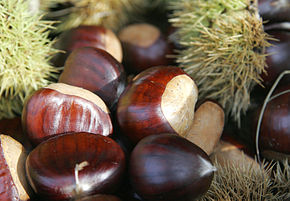Nut (fruit)

A nut in botany is a simple dry fruit in which the ovary wall becomes increasingly hard as it matures, and where the seed remains unattached or free within the ovary wall. Most nuts come from the pistils with inferior ovaries (see flower) and all are indehiscent (not opening at maturity). True nuts are produced, for example, by some plant families of the order Fagales. Order Fagales (not all species produce true nuts) Family Fagaceae Beech (Fagus) Chestnut (Castanea) Oak (Quercus) Stone-oak (Lithocarpus) Tanoak (Notholithocarpus) Family Betulaceae Hazel, Filbert (Corylus) Hornbeam (Carpinus) A small nut may be called a "nutlet". In botany, this term specifically refers to a pyrena or pyrene, which is a seed covered by a stony layer, such as the kernel of a drupe. Walnuts and hickories (Juglandaceae) have fruits that are difficult to classify. They are considered to be nuts under some definitions, but are also referred to as drupaceous nuts. "Tryma" is a specialized term for hickory fruits. In common use, a "tree nut" is, as the name implies, any nut coming from a tree. This most often comes up regarding allergies, where some people are allergic specifically to peanuts (which are not tree nuts), others to a wider range of nuts that grow in trees. Culinary definition and uses A walnut, left, and its seed, right, having been removed from its pericarp Seeds of the Korean pine in shell and empty shell, above; removed from shell, below A nut in cuisine is a much less restrictive and older meaning of the word than the narrow meaning of nut in botany; the term is applied to many seeds that are not botanically nuts. Any large, oily kernels found within a shell and used in food are commonly called nuts. Nuts are an important source of nutrients for both humans and wildlife.[3] Because nuts generally have a high oil content, they are a highly prized food and energy source. A large number of seeds are edible by humans and used in cooking, eaten raw, sprouted, or roasted as a snack food, or pressed for oil that is used in cookery and cosmetics.[3] Nuts used for food, whether true nut or not, are among the most common food allergens.[3][4] Raw mixed nuts, sold as a snack food. This is a "fancy" mix, meaning that it does not include peanuts. Some fruits and seeds that do not meet the botanical definition but are nuts in the culinary sense are:[3] Almonds are the edible seeds of drupe fruits – the leathery "flesh" is removed at harvest. Brazil nut is the seed from a capsule. Candlenut (used for oil) is a seed. Cashew is the seed[5] of a drupe fruit with an accessory fruit. Chilean hazelnut or Gevuina. Macadamia is a creamy white kernel of a follicle type fruit. Malabar chestnut. Mongongo nut. Peanut is a seed and from a legume type fruit (of the family Fabaceae). Pecan is the seed of a drupe fruit. Pili nut is the seed of the tropical tree Canarium ovatum which grows in the Philippines, Indonesia and Papua New Guinea. Pine nut is the seed of several species of pine (coniferous trees). Pistachio is the partly dehiscent seed of a thin-shelled drupe. Walnut (Juglans) is the seed of a drupe fruit. Yeheb nut is the seed of a desert bush, Cordeauxia edulis. Nutrition Constituents Nuts are the source of energy and nutrients for the new plant. They contain a relatively large quantity of calories, essential unsaturated and monounsaturated fats including linoleic acid and linolenic acid, vitamins, and essential amino acids.[3] Many nuts are good sources of vitamin E, vitamin B2, folate, fiber, and the essential minerals magnesium, phosphorus, potassium, copper, and selenium.[3][6] Nuts are most healthy in their raw unroasted form because roasting can significantly damage and destroy fats during the process.[7] A graph detailing the nutritional properties of nuts and oily seeds. This table lists the percentage of various nutrients in four unroasted seeds. Name Protein Total fat Saturated fat Polyunsaturated fat Monounsaturated fat Carbohydrate Almonds 21.26 50.64 3.881 12.214 32.155 28.1 Walnuts 15.23 65.21 6.126 47.174 8.933 19.56 Peanuts 23.68 49.66 6.893 15.694 24.64 26.66 Pistachio 20.61 44.44 5.44 13.455 23.319 34.95
